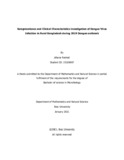| dc.contributor.advisor | Naser, Iftekhar Bin | |
| dc.contributor.advisor | Rahman, Md Mustafizur | |
| dc.contributor.author | Rashed, Afsana | |
| dc.date.accessioned | 2021-08-01T09:58:05Z | |
| dc.date.available | 2021-08-01T09:58:05Z | |
| dc.date.copyright | 2021 | |
| dc.date.issued | 2021-01 | |
| dc.identifier.other | ID 15326007 | |
| dc.identifier.uri | http://hdl.handle.net/10361/14891 | |
| dc.description | This thesis is submitted in partial fulfilment of the requirements for the degree of Bachelor of Science in Microbiology, 2021. | en_US |
| dc.description | Catalogued from PDF version of thesis. | |
| dc.description | Includes bibliographical references (pages 53-57). | |
| dc.description.abstract | Dengue virus (DENV), a single-stranded RNA virus belonging to Flaviviridae family member, is transmitted by Aedes aegypti and Aedes albopictus mosquitoes. Dengue is a mosquito-borne viral disease that has become more prevalent in the last few decades. DENV infection which may remain asymptomatic or manifest as life threatening dengue haemorrhagic fever (DHF) or dengue shock syndrome (DSS) is one of the most emerging viral diseases in the world. As the clinical presentations ranging from asymptomatic to severe illness may lead to death if improperly managed, the information on the incidence of DENV infections along with the clinical manifestations are significant in preventing future outbreaks. In this study, DENV infections were investigated in clinically suspected dengue fever patients from Faridpur Medical College hospital during September 2019 epidemic in rural Bangladesh. The objective of the current study was to explore the circulating dengue serotypes in rural Bangladesh during that season. A total of 66 serum samples were obtained from Faridpur Medical college Hospital during 2019 DENV epidemic in Bangladesh which were tested for dengue virus using nucleic acid extraction, conventional RT-PCR assay for the presence of DENV RNA, agarose gel electrophoresis followed by nucleotide sequencing using DENV type specific primers that targeted the dengue virus serotype 1–4. DENV RNA was detected from 10 cases (15% of 66 patients). The DENV sequencing using type specific primers detected DENV-3 in eight patients, DENV 2 in one patient and one sample was untypeable in the sequencing method. Also, analysis of clinical observations showed that vomiting, headache, lethargy and restlessness were the most prevalent complains among the investigated dengue positive patients. Other common signs and symptoms were conjunctivitis, arthritis, hepatomegaly and skin rash. Isolation of DENV RNA and the updated knowledge of the circulating DENV serotypes and associated clinical manifestations are of utmost significance for understanding and predicting possible future emergence of a different serotype which can help in public health preparedness tremendously. | en_US |
| dc.description.statementofresponsibility | Afsana Rashed | |
| dc.format.extent | 57 pages | |
| dc.language.iso | en | en_US |
| dc.publisher | Brac University | en_US |
| dc.rights | Brac University theses are protected by copyright. They may be viewed from this source for any purpose, but reproduction or distribution in any format is prohibited without written permission. | |
| dc.subject | Rural Bangladesh | en_US |
| dc.subject | Dengue virus | en_US |
| dc.subject | Clinical characteristics | en_US |
| dc.subject | Seroprevalence | en_US |
| dc.subject.lcsh | Dengue | |
| dc.subject.lcsh | Dengue--Prevention | |
| dc.title | Seroprevalence and clinical characteristics investigation of Dengue virus infection in rural Bangladesh during 2019 Dengue outbreak | en_US |
| dc.type | Thesis | en_US |
| dc.contributor.department | Department of Mathematics and Natural Sciences, Brac University | |
| dc.description.degree | B. Microbiology | |

